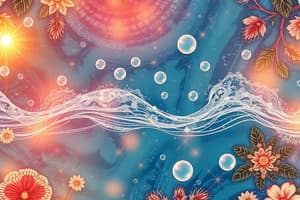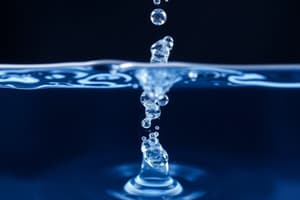Podcast
Questions and Answers
Why is water considered the foundation of life and a central component of environmental balance?
Why is water considered the foundation of life and a central component of environmental balance?
Water constitutes a large percentage of body weight, serves as a medium for chemical reactions and metabolism, regulates body temperature, and acts as a transport system for nutrients.
Besides domestic, agricultural and industrial uses, what is another example of water use?
Besides domestic, agricultural and industrial uses, what is another example of water use?
Recreational purposes, like swimming.
What makes water a polar molecule, and how does this property contribute to its dissolving capabilities?
What makes water a polar molecule, and how does this property contribute to its dissolving capabilities?
The bent shape and unequal charge distribution make it polar, allowing it to attract and dissolve other polar molecules.
Explain one way urban sprawl can negatively affect water quality?
Explain one way urban sprawl can negatively affect water quality?
How does the process of biomagnification impact aquatic ecosystems, as illustrated by the example of PCBs?
How does the process of biomagnification impact aquatic ecosystems, as illustrated by the example of PCBs?
Describe the role of microorganisms in biochemical oxygen demand (BOD) and what high BOD indicates?
Describe the role of microorganisms in biochemical oxygen demand (BOD) and what high BOD indicates?
What is a potential consequence of industrial effluent discharge beyond heavy metal contamination?
What is a potential consequence of industrial effluent discharge beyond heavy metal contamination?
Describe how total dissolved solids (TDS) can impact the suitability of water for use, and what is the acceptable limit for drinking water?
Describe how total dissolved solids (TDS) can impact the suitability of water for use, and what is the acceptable limit for drinking water?
In the context of water quality, what is the significance of monitoring total suspended solids (TSS)?
In the context of water quality, what is the significance of monitoring total suspended solids (TSS)?
Explain what causes temporary hardness in water, and how it can be removed?
Explain what causes temporary hardness in water, and how it can be removed?
How does the measurement of pH indicate the acidity or basicity of water, and what is the desired pH range for drinking water?
How does the measurement of pH indicate the acidity or basicity of water, and what is the desired pH range for drinking water?
Besides pathogens, what are some other factors potable water must be free from?
Besides pathogens, what are some other factors potable water must be free from?
Explain why odors in water are a parameter to test when testing water quality?
Explain why odors in water are a parameter to test when testing water quality?
How can the use of de-icing compounds impact the biochemical oxygen demand (BOD) levels in aquatic environments?
How can the use of de-icing compounds impact the biochemical oxygen demand (BOD) levels in aquatic environments?
With regards to water quality monitoring, what is the role of testing for electrical conductivity?
With regards to water quality monitoring, what is the role of testing for electrical conductivity?
Flashcards
Importance of water
Importance of water
Water is a foundation of life, essential for environmental balance and comprises about 70% of human body weight.
Polarity of Water
Polarity of Water
The bent shape of a water molecule makes it polar, giving partial charges to oxygen and hydrogen atoms.
Water Quality Variables
Water Quality Variables
Indicators include chemical, biological, or physical characteristics making water unfit for specific uses.
Water Pollution Sources
Water Pollution Sources
Signup and view all the flashcards
Key Water Quality Parameters
Key Water Quality Parameters
Signup and view all the flashcards
Water Color Measurement
Water Color Measurement
Signup and view all the flashcards
Biochemical Oxygen Demand (BOD)
Biochemical Oxygen Demand (BOD)
Signup and view all the flashcards
Water Hardness
Water Hardness
Signup and view all the flashcards
Safe Turbidity Level
Safe Turbidity Level
Signup and view all the flashcards
Unwanted Substances
Unwanted Substances
Signup and view all the flashcards
Factors Influencing Water Quality
Factors Influencing Water Quality
Signup and view all the flashcards
Total Suspended Solids (TSS)
Total Suspended Solids (TSS)
Signup and view all the flashcards
Residual Chlorine
Residual Chlorine
Signup and view all the flashcards
Study Notes
- The total amount of water on the planet is estimated at 10^9.
- Approximately 97% of the planet's water is saltwater found in oceans, seas, and depths of the earth.
- Only about 3% of the planet's water is fresh drinking water.
- To meet water needs for domestic, agricultural, and industrial uses, many countries use desalination techniques, which are often expensive.
- Water is the foundation of life and a central component of environmental balance.
- Water constitutes about 70% of the weight of the human body.
- Water forms the medium for chemical reactions and metabolism.
- Water maintains body temperature.
- Water enters into the synthesis of enzymes and tissues.
- Water is the medium through which nutrients travel to cells.
- The bent molecule shape makes water polar, giving the oxygen atom a partial negative charge and the hydrogen atoms partial positive charges.
- The partial charges attract parts of polar molecules to dissolve them, but water does not dissolve nonpolar molecules.
- Ocean covers 71% of Earth's surface, which amounts to 196,950,000 sq mi (510,000,000 sq km).
Water Quality Monitoring
- Knowing how the quality and quantity of water relate to the requirements of users is important.
- Water quality monitoring can establish standards.
- It assesses the capacity of a water body to assimilate waste without causing unacceptable pollution levels.
- It also determines if waste discharges conform to existing standards and regulations.
- Appropriateness and effectiveness of control strategies and management actions for pollution control is a factor.
- Water quality monitoring tracks the trends of changes in water quality over time due to human activities in the catchment area.
Water quality decline
- Decline can result from waste discharges.
- Improvement can come from pollution control measures.
- It identifies control measures that should be implemented to improve or prevent further deterioration of water quality.
- It identifies chemical or biological variables rendering water unsuitable for beneficial uses.
- It identifies hazards to human health resulting from poor water quality in the water body.
- It assesses how developments in the catchment area have affected or will affect water quality.
- It determines the effects of deteriorating water quality on plant and animal life in or near the water body.
Sources of Water Pollution
- Sources include polluted air, coal strip mine runoff, de-icing road salt, pumping wells, waste lagoons, accidental spills, buried gasoline and solvent tanks, gasoline stations, water pumping wells, landfills, and sewers.
- Other sources are hazardous waste injection wells, cesspools, septic tanks, and leakage from faulty casings.
- Groundwater flow, industry, cities, urban sprawl, and farms all cause water pollution.
- De-icing compounds affect biochemical oxygen demand levels, and include chlorides, acetates, glycols and ABPS.
Categories of water quality parameters:
- Physical parameters include pH, electrical conductivity (EC), total dissolved solids (TDS), temperature (T), dissolved oxygen (DO), color, odor, turbidity, and total suspended matter (TSM), biochemical oxygen demand (BOD), and chemical oxygen demand (COD).
- Chemical parameters include bicarbonate (HCO3-), carbonate (CO2-), chloride (Cl-), nitrate (NO3), nitrite (NO2), sulfate (SO42-), phosphate (PO43-), fluoride (F), dissolved silica (SiO2), aluminum (Al), boron (B), calcium (Ca), potassium (K), sodium (Na), magnesium (Mg), selenium (Se), arsenic (As), mercury (Hg), iron (Fe(II)/Fe(III)), manganese (Mn), ammonia (NH4+), and heavy metals.
- Organic parameters include total organic carbon (TOC), particulate organic carbon (POC), dissolved organic carbon (DOC), dissolved inorganic carbon (DIC), phenols, chlorinated hydrocarbons, polycyclic aromatic hydrocarbons, and pesticides.
- Biological Parameters include chlorophyll-a, cyanobacteria, microbiological elements (i.e., fecal coliforms, Total Coliform) and macrobiotic elements, such as worms, plankton and fish.
Essential Qualities of Potable Water
- Potable water must be colorless, odorless, with turbidity less.
- The pH must be between 6.5 and 8.5.
- Specific conductance should be 300 mmho cm-1.
- Dissolved oxygen should be 4-6 parts per million (ppm).
- Biochemical oxygen demand (BOD) should be less than 1 ppm.
- Total dissolved solids (TDS) should be 500 NTU.
- Total Coliform count should be 50/100 ml, and free from radioactive substances.
Problems affecting potable water
- Pathogens and other disease-causing agents, cloudiness/turbidity, methane, sulfur dioxide, ammonia, anions like fluoride, nitrate, phosphate, cyanide, and toxic heavy metals.
- POPs, VOCs, PAEs, PAHs, and pesticide residues.
Field Parameters
- Measured in the field routinely consisting of temperature, pH, conductivity, alkalinity, and oxidation/reduction values.
- Aesthetic testing is recommended alongside water testing, noting aesthetic qualities like color, temperature, and cloudiness
- Color should be addressed immediately.
- Tasting and smelling water is highly recommended.
- Total Dissolved Solids (TDS) analysis is based on gravimetric estimation.
- Analysis of residual chlorine is done by argentometric titration method.
- The maximum acceptable limit of chloride (as Cl) is 250 mg/L, while free residual chlorine is 0.2 mg/L.
Hardness of water parameters
- Temporary and permanent hardness occurs within hardness of water.
- EDTA titration method is widely used to analyze total harness in water.
- Biochemical Oxygen Demand (BOD) is a parameter to estimate the measurement of initial DO and the measure after 5 days.
- 5 mg/L is the recommended allowance.
- Surveillance of water samples checks for a variety of chemicals, pathogens and materials.
Studying That Suits You
Use AI to generate personalized quizzes and flashcards to suit your learning preferences.




